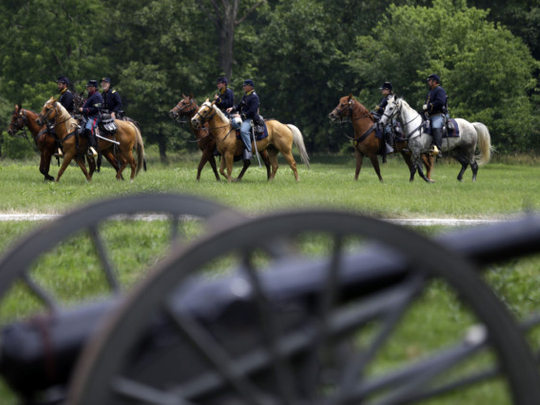
Standing in the middle of the gruesome battle scene during Pickett’s Charge, surrounded by the horrific sight of 12,000 infantrymen fighting, bloodied, mangled and dying, some of the most hardened soldiers were brought to tears.
But that was two decades after the decisive 1863 battle. The soldiers described in newspaper accounts as being overcome with emotion were Civil War veterans looking at a massive in-the-round painting, known as a cyclorama, a grand illusion recreating the pivotal battle with a level of realism not seen before.
“They were the IMAX of their day,” said Katie Lawhon, spokesperson for Gettysburg National Military Park. The National Park Service has owned the cyclorama since 1942.
Visitors coming for the 150th anniversary of the Battle of Gettysburg will experience the four-storey cyclorama, one of only three known to survive in the United States, fully restored in a new visitor centre with a dramatic light and sound show.
As much novelty as fine art, cycloramas commonly depicted military or religious scenes and were displayed in purpose-made buildings.
Hung inside a rotunda, a properly installed cyclorama creates an immersive 360-degree experience thanks to its colossal size and meticulous details. A diorama in front of the canvas adds to the effect by extending the scene in 3D.
French artist Paul Philippoteaux and a team of 20 painters created four identical Gettysburg cycloramas in all, based on his sketches and photos of the landscape, historical accounts and interviews with Pickett’s Charge survivors. They were so popular that a number of Philippoteaux knock-offs started making the state fair rounds.
“When Paul Philippoteaux is finished with the paintings and lays everyone off, those master drawings get out there and other competing companies acquired the artist and drawing,” said Sue Boardman, programme manager with the Gettysburg Foundation and a cyclorama expert.
Philippoteaux signed his work by adding his likeness, leaning against a tree in a Union uniform, as soldiers around him charge the front line. The work was otherwise politically neutral: whether Union or Confederate, all Philippoteaux’s soldiers fight heroically and die with honour.
“He would tinker with it if someone who was there told him a detail that wasn’t right,” Lawhon said. “He continued to make changes after it was completed.”
Motion pictures killed the cyclorama craze, and they began to quickly vanish by the late 1800s. The only other one still on display depicts the Battle of Atlanta and resides in that city.
Gettysburg’s cyclorama was originally displayed in Boston, then spent a decade languishing boxed in an open shed that a Boston newspaper colourfully mourned as a “mausoleum of greatness”. It was purchased by a retail mogul, who chopped it up for display, and eventually arrived in its present hometown exactly a century ago, already the worse for wear.
Time was also not any kinder in the decades that followed. By the 1990s, it “was so aesthetically compromised that ... the illusion it was once capable of creating could only be read in century-old accounts,” Boardman said.
A five-year, $15 million (Dh55 million) upgrade completed in 2008 repaired deterioration from heat, moisture, pollution, neglect and ill-advised repair attempts. The cyclorama’s former 1960s dwelling by modernist architect Richard Neutra wasn’t as lucky: it was demolished recently after preservationists lost a lengthy court battle.
Conservators separated the painting’s 27 panels and cleaned each one inch by inch with cotton swabs, stabilised brittle areas and removed bad touch-ups and damaging glue. A missing 4-metre vertical section and a 3-metre horizontal slice of sky were replaced.
“The colours are very vivid,” Lawhon said. “We have to remind visitors that it’s from 1884 because it doesn’t look it.”
Visual tricks such as an elevated viewing platform heighten the perception of being in the action. Restorers rehung the canvas so the centre bows inward as originally intended, and they reconstructed a long-absent diorama of trees, fences, stone walls and a cannon, Lawhon said.
“When it’s stretched correctly, it’s best for the canvas, and it’s best for the eye when you’re at the horizon level,” she said. “It had been hung incorrectly for decades and it’s much more dramatic. People who haven’t seen it in a while will be surprised.”


